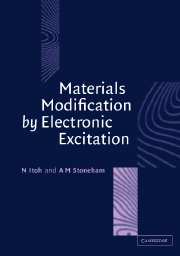Book contents
- Frontmatter
- Contents
- Preface
- 1 Concepts: Excitation, polarons and electronic structure
- 2 Energy deposition and redistribution in solids
- 3 Electron–lattice coupling and its consequences
- 4 Self-trapping
- 5 Local lattice modification by electronic excitation of halides
- 6 Local lattice modification by electronic excitation of crystalline insulating oxides
- 7 Local lattice modification of semiconductors by electronic excitation
- 8 Local lattice modification of amorphous materials by electronic excitation
- 9 Atomic emission and surface modification
- 10 Interface reactions induced by electronic excitation
- 11 High excitation intensities
- 12 Applications of materials modification by excitation
- References
- Index
1 - Concepts: Excitation, polarons and electronic structure
Published online by Cambridge University Press: 11 August 2009
- Frontmatter
- Contents
- Preface
- 1 Concepts: Excitation, polarons and electronic structure
- 2 Energy deposition and redistribution in solids
- 3 Electron–lattice coupling and its consequences
- 4 Self-trapping
- 5 Local lattice modification by electronic excitation of halides
- 6 Local lattice modification by electronic excitation of crystalline insulating oxides
- 7 Local lattice modification of semiconductors by electronic excitation
- 8 Local lattice modification of amorphous materials by electronic excitation
- 9 Atomic emission and surface modification
- 10 Interface reactions induced by electronic excitation
- 11 High excitation intensities
- 12 Applications of materials modification by excitation
- References
- Index
Summary
Basic ideas about the localisation of charge and energy
Our theme is excited state phenomena in materials, and the way that excitation can affect the nature and performance of materials. The emphasis on excited states means that we are primarily concerned with non-metals, although certain of the interesting features do not depend on the existence of a bandgap. It is natural that excited states evolve with time as equilibrium is reestablished. Our concern includes the ways in which the direction of this evolution can be controlled, for example, so as to produce chosen defect populations. How this happens, and the degree of control which is possible, depends on how the excitation energy is provided as well as on the intrinsic features of the excited states.
The components of materials modification by excitation can be classified in a few categories, although the mechanisms may be very varied. First, there are the transport processes: energy transport and charge transport. These are the processes by which excitation reaches specific regions of a solid. Control of which zones are affected and which are unaffected is important in any proposed application. Secondly, there are the localisation processes: energy localization and charge localization. Energy localisation can often be described as the trapping or self-trapping of an exciton. In some cases, it will be preceded by charge localisation, as in the trapping or self-trapping of a hole followed by capture of an electron.
- Type
- Chapter
- Information
- Materials Modification by Electronic Excitation , pp. 1 - 56Publisher: Cambridge University PressPrint publication year: 2000

